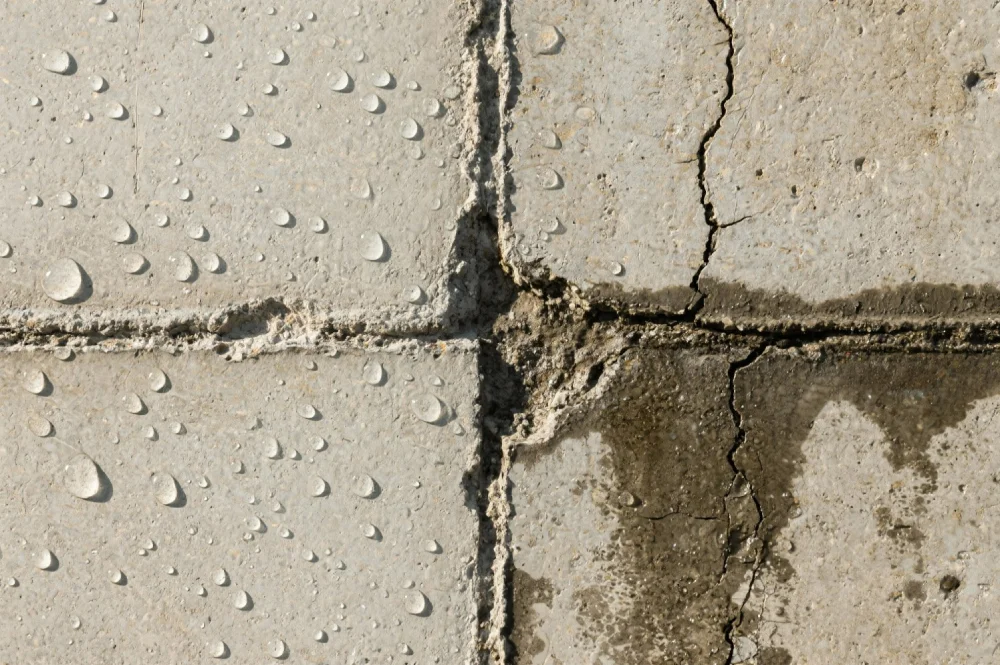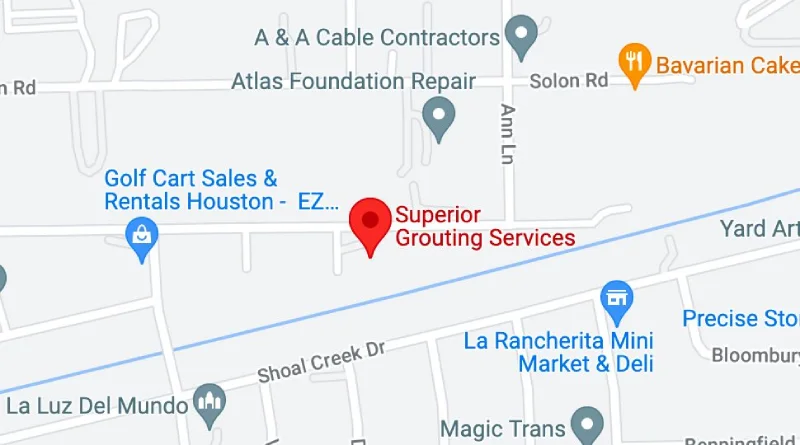Which Grout Stops Leaks Better: Hydrophobic or Hydrophilic?

The choice between hydrophobic and hydrophilic grout for leak repair depends on specific water conditions and project requirements. Hydrophilic grout excels at stopping active or large-volume water leaks because it absorbs water and expands significantly to fill cracks thoroughly. Hydrophobic grout provides superior long-term durability and sealing in areas where water exposure is intermittent or moisture conditions vary.
Understanding the performance characteristics of each grout type helps engineers and contractors select the most effective solution for their specific leak repair needs. Both types offer distinct advantages depending on water flow conditions, structural requirements, and environmental factors.
For infrastructure projects across Texas and nationwide, choosing the right grout type can mean the difference between a temporary fix and a permanent solution. Professional polyurethane grouting services ensure proper material selection and application for optimal leak-stopping performance.
Key Takeaways
- Hydrophilic grout works better for active, continuous leaks because it absorbs water and expands dramatically to fill large gaps and provide thorough sealing.
- Hydrophobic grout excels in long-term durability and performs better in areas with intermittent water exposure or fluctuating moisture conditions.
- Water volume and flow rate are critical factors in grout selection, with hydrophilic types handling high-volume leaks more effectively than hydrophobic alternatives.
- Hydrophilic grout offers self-healing properties that allow continued expansion if new cracks form, making it ideal for dynamic structural conditions.
- Hydrophobic grout maintains consistent volume and mechanical strength over time, providing superior performance in wet-dry cycle environments.
- Professional assessment of leak conditions, structural requirements, and environmental factors is essential for selecting the most effective grout type for each application.
Understanding Hydrophilic Grout Performance
Hydrophilic polyurethane grout is specifically designed to interact with water, using moisture as a catalyst for expansion and curing. This water-reactive property makes it particularly effective for certain leak repair applications.
Water Absorption and Expansion Mechanics
Hydrophilic grout undergoes dramatic volume changes when exposed to water, with some formulations expanding up to 2000% of their original volume according to polyurethane engineering research. This expansion mechanism allows the material to fill even large voids and cracks effectively.
The expansion process occurs through a chemical reaction where water molecules are incorporated into the polymer structure, causing the grout to foam and fill available space. This reaction is particularly effective in high-moisture environments where continuous water flow is present.
Expansion Characteristics:
- Initial reaction begins within seconds of water contact
- Peak expansion typically reached within 15-30 minutes
- Can expand to fill cracks up to several inches wide
- Maintains elasticity while providing waterproof barrier
- Continues expanding if additional water is introduced
Performance in Active Leak Conditions
Hydrophilic grout demonstrates superior performance when dealing with active water infiltration, particularly in applications like dam repairs, tunnel sealing, and basement waterproofing where continuous water flow is present.
| Leak Condition | Hydrophilic Performance | Key Advantages |
| High-Volume Leaks | Excellent | Rapid expansion fills large gaps |
| Continuous Flow | Superior | Uses water for strength development |
| Dynamic Cracks | Very Good | Self-healing expansion properties |
| Seasonal Variations | Good | Adapts to changing water conditions |
Self-Healing Properties
One of the most significant advantages of hydrophilic grout is its ability to continue expanding and sealing if structural movement creates new cracks or enlarges existing ones. This self-healing property is particularly valuable for infrastructure applications in Texas where soil movement and temperature fluctuations can affect structural integrity.
Understanding Hydrophobic Grout Performance
Hydrophobic polyurethane grout is engineered to repel water while forming a dense, mechanically strong barrier that provides excellent long-term durability. This water-repelling characteristic makes it suitable for specific applications where water resistance rather than water interaction is desired.
Water Repulsion and Curing Mechanism
Unlike hydrophilic grouts, hydrophobic formulations cure through moisture catalysis without significant volume expansion. The curing process creates a rigid, water-resistant structure that maintains consistent dimensions over time.
The hydrophobic nature means the grout does not absorb water after curing, preventing potential degradation from freeze-thaw cycles or chemical attack from water-borne contaminants. This stability is crucial for long-term infrastructure applications.
Curing Characteristics:
- Rapid initial cure with high early strength development
- Minimal volume change during and after curing
- Dense, impermeable final structure
- Excellent chemical resistance properties
- Maintains properties through environmental cycling
Long-Term Durability Advantages
Hydrophobic grout excels in applications requiring long-term performance stability, particularly in environments with varying moisture conditions or exposure to aggressive chemicals.
Durability Benefits:
- Resistant to freeze-thaw damage from water absorption
- Maintains mechanical properties over decades of service
- Excellent resistance to chemical attack from groundwater
- Stable performance in wet-dry cycling conditions
- Minimal maintenance requirements after installation
Mechanical Strength Properties
The rigid curing characteristics of hydrophobic grout result in high compressive and tensile strength values, making it suitable for structural applications where load-bearing capacity is important.
According to ASTM D1621 testing procedures, properly cured hydrophobic grouts can achieve compressive strengths exceeding 3000 psi, providing structural support in addition to water sealing capabilities.
Leak Condition Assessment for Grout Selection
Proper evaluation of leak conditions is essential for selecting the most effective grout type. Different water infiltration patterns require different material approaches for optimal results.
Active vs. Intermittent Leak Classification
Understanding the nature of water infiltration helps determine which grout type will provide better long-term performance.
| Leak Type | Water Flow Pattern | Recommended Grout Type | Reasoning |
| Active Gushing | Continuous high-volume flow | Hydrophilic | Uses water flow for expansion |
| Seeping | Steady low-volume infiltration | Hydrophilic | Gradual expansion seals thoroughly |
| Intermittent | Periodic water exposure | Hydrophobic | Stable in wet-dry cycles |
| Seasonal | Variable with weather patterns | Hydrophobic | Consistent performance over time |
Volume and Pressure Considerations
Water volume and pressure significantly impact grout selection and application success. High-pressure applications may require different approaches than low-pressure seepage conditions.
High-Pressure Applications:
- Require initial pressure resistance during application
- May benefit from staged injection techniques
- Need materials that can withstand hydraulic forces
- Often found in dam and levee applications
Low-Pressure Applications:
- Allow for gentler material placement
- Can utilize gravity-fed injection methods
- Focus on long-term sealing rather than pressure resistance
- Common in basement and foundation repair
Environmental Factor Analysis
Environmental conditions at the repair site influence material performance and longevity. Texas infrastructure projects must consider factors like temperature extremes, soil chemistry, and seasonal weather patterns.
Critical Environmental Factors:
- Temperature range and thermal cycling effects
- Soil pH and chemical compatibility
- Groundwater chemistry and contamination levels
- Seismic activity and structural movement potential
- Accessibility for future maintenance or re-treatment
Application-Specific Performance Comparison
Different infrastructure applications present unique challenges that favor one grout type over another based on specific performance requirements and environmental conditions.
Dam and Levee Applications
Dam and levee structures typically experience continuous water pressure and potential for significant leakage volumes, making material selection critical for both immediate sealing and long-term structural integrity.
Hydrophilic grout often performs better in active leak scenarios common in these applications, particularly where water flow can be substantial during peak conditions. However, hydrophobic grout may be preferred for areas subject to water level fluctuations.
Dam Application Considerations:
- High water pressure requires robust sealing
- Continuous submersion favors hydrophilic expansion
- Access limitations require durable solutions
- Safety implications demand reliable performance
Tunnel Waterproofing
Tunnel applications present unique challenges with varying water conditions, limited access for repairs, and requirements for long-term reliability without maintenance.
The choice between hydrophilic and hydrophobic grout often depends on the specific section of tunnel and local groundwater conditions. Areas with consistent water infiltration may benefit from hydrophilic grout, while sections with variable exposure may perform better with hydrophobic materials.
Water Treatment Facility Repairs
Water treatment facilities require grout materials that can withstand chemical exposure while maintaining sealing effectiveness. The choice between hydrophilic and hydrophobic options depends on the specific chemicals present and exposure patterns.
According to EPA water treatment infrastructure guidelines, materials used in water treatment applications must meet specific chemical resistance requirements to ensure long-term performance and prevent contamination.
Professional Application Techniques
Proper application techniques are crucial for achieving optimal performance from either grout type. Professional grouting services ensure proper material selection, preparation, and installation procedures.
Pre-Application Assessment
Thorough evaluation of leak conditions, structural requirements, and environmental factors guides material selection and application approach.
Assessment Protocols:
- Water flow measurement and characterization
- Structural condition evaluation and crack mapping
- Environmental condition analysis and monitoring
- Access and equipment requirement determination
- Safety hazard identification and mitigation planning
Injection Procedures and Equipment
Different grout types may require specific injection equipment and techniques for optimal results. Professional contractors have experience with various application methods and equipment configurations.
| Application Method | Best For | Equipment Required | Typical Applications |
| Low-Pressure Injection | Small cracks, seepage | Hand pumps, basic equipment | Basement walls, minor leaks |
| High-Pressure Injection | Active leaks, structural gaps | Powered pumps, specialized packers | Dam repairs, major leaks |
| Gravity Feed | Large void filling | Mixing equipment, pour systems | Annular space filling |
| Multi-Stage | Complex repairs | Advanced monitoring equipment | Critical infrastructure |
Quality Control and Testing
Professional application includes quality control measures to verify proper grout placement and cure characteristics. Testing protocols help ensure the repair will perform as intended over its design life.
Quality Assurance Measures:
- Pre-injection material testing and verification
- Real-time monitoring during application
- Post-cure strength and impermeability testing
- Long-term performance monitoring and evaluation
- Documentation for warranty and maintenance planning
Cost-Effectiveness Analysis
Evaluating the total cost of ownership for different grout types includes initial material costs, application expenses, and long-term maintenance requirements.
Material Cost Comparison
While material costs vary based on specific formulations and quantities, the total project cost should consider performance characteristics and expected service life.
Cost Factors:
- Initial material purchase price per gallon or pound
- Application labor requirements and time
- Equipment needs and rental costs
- Potential for re-treatment or maintenance
- Project downtime and associated costs
Long-Term Value Considerations
The most cost-effective solution considers both immediate performance and long-term reliability. A more expensive material that provides decades of service may offer better value than a cheaper option requiring frequent maintenance.
For Texas infrastructure projects, long-term value is particularly important given the scale of many applications and the difficulty of accessing repair sites for maintenance.
Return on Investment Analysis
Professional contractors can provide return on investment analysis comparing different grout options based on expected performance, maintenance requirements, and total lifecycle costs.
ROI Factors:
- Initial repair cost versus expected service life
- Maintenance frequency and associated costs
- Downtime costs for critical infrastructure
- Safety and liability considerations
- Regulatory compliance and reporting requirements
Selection Guidelines for Optimal Performance
Choosing between hydrophobic and hydrophilic grout requires careful consideration of multiple factors to ensure optimal leak-stopping performance and long-term reliability.
Decision Matrix Framework
A systematic approach to grout selection considers all relevant factors and their relative importance for the specific application.
| Selection Factor | Hydrophilic Advantage | Hydrophobic Advantage | Weight Factor |
| Active Water Flow | High | Low | Critical |
| Long-Term Durability | Moderate | High | Important |
| Structural Movement | High | Low | Important |
| Chemical Resistance | Low | High | Variable |
| Maintenance Access | Moderate | High | Important |
Professional Consultation Benefits
Working with experienced pressure grouting professionals ensures proper material selection based on comprehensive site evaluation and application expertise.
Professional Services Include:
- Detailed leak condition assessment and characterization
- Material recommendation based on specific requirements
- Application planning and equipment selection
- Quality control during installation and curing
- Long-term performance monitoring and maintenance planning
Regional Considerations for Texas Projects
Texas infrastructure projects must consider specific regional factors including soil conditions, climate patterns, and regulatory requirements that may influence material selection and application approaches.
Texas-Specific Factors:
- Expansive clay soil conditions affecting structural movement
- Temperature extremes and thermal cycling effects
- Seasonal weather patterns and flooding potential
- State and federal regulatory requirements for infrastructure
- Access to specialized equipment and experienced contractors
Conclusion
The choice between hydrophobic and hydrophilic grout for leak repair depends on specific water conditions, structural requirements, and long-term performance expectations. Hydrophilic grout excels at stopping active, continuous leaks through dramatic expansion and self-healing properties, while hydrophobic grout provides superior long-term durability in varying moisture conditions.
Professional assessment of leak conditions, environmental factors, and project requirements is essential for selecting the most effective grout type. Working with experienced contractors ensures proper material selection, application techniques, and quality control for optimal leak-stopping performance.
Superior Grouting provides expert consultation and professional application services for both hydrophilic and hydrophobic grout systems, helping clients achieve reliable, long-lasting leak repair solutions for critical infrastructure projects. For professional evaluation of your leak repair needs and material recommendations, contact our experienced team.

